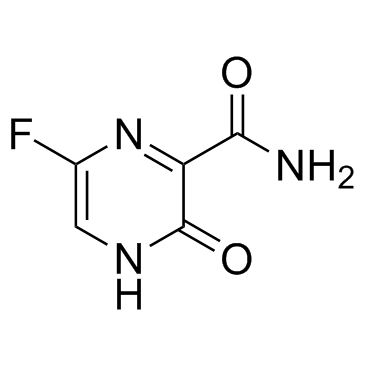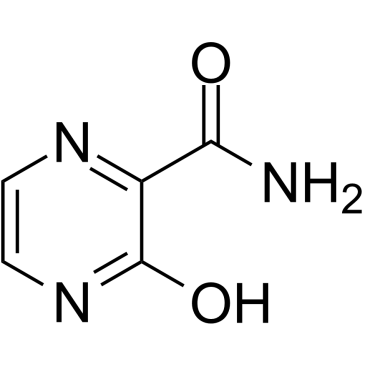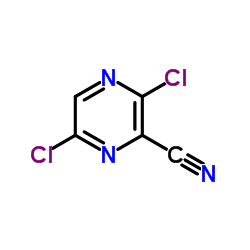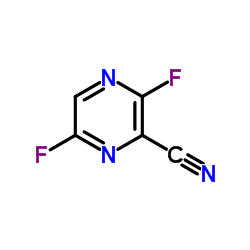259793-96-9
| Name | 5-fluoro-2-oxo-1H-pyrazine-3-carboxamide |
|---|---|
| Synonyms |
6-fluoro-3-oxo-3,4-dihydropyrazine-2-carboxamide
2-Pyrazinecarboxamide,6-fluoro-3-hydroxy T-705 6-fluoro-3-hydroxy-2-pyrazinecarboxamide 6-Fluoro-3-oxo-3,4-dihydro-2-pyrazinecarboxamide 2-Pyrazinecarboxamide, 6-fluoro-3,4-dihydro-3-oxo- Avigan 6-Fluoro-3-hydroxypyrazine-2-carboxamide favipiravir UNII-EW5GL2X7E0 |
| Description | Favipiravir is a novel viral RNA polymerase inhibitor, it is phosphoribosylated by cellular enzymes to its active form, Favipiravir-ribofuranosyl-5′-triphosphate (RTP). Favipiravir-RTP inhibits the influenza viral RNA-dependent RNA polymerase (RdRP) activity with IC50 of 341 nM. |
|---|---|
| Related Catalog | |
| Target |
IC50: 341 nM (RdRP)[1] |
| In Vitro | Favipiravir (T 705) is an antiviral drug that selectively inhibits the RNA-dependent RNA polymerase of influenza virus. Favipiravir (T 705) is a novel antiviral compound that selectively and potently inhibits the RNA-dependent RNA polymerase (RdRP) of influenza and many other RNA viruses. Favipiravir-RTP does not inhibit the human DNA polymerase α, β or γ with IC50>1 mM. The IC50 for the human RNA polymerase II is 905 μM; Favipiravir is therefore 2,650 times more selective for the influenza virus RdRP, consistent with the lack of inhibition of host-cell DNA and RNA synthesis[1]. Favipiravir (T 705) acts as a pro-drug, its cytotoxicity is expected to be cell-line dependent. Favipiravir inhibits in a dose-dependent manner MNV-induced CPE (EC50: 250±11 μM) and MNV RNA synthesis in cell culture (EC50:124±42 μM). Despite this rather modest antiviral activity, Favipiravir (T 705) is able to completely inhibit norovirus replication at a concentration of 100 μg/mL, which is a concentration that has little or no adverse effect on the host cell (cell viability >80%)[2]. |
| In Vivo | Favipiravir (T 705) (30 mg/kg/day, orally) improves survival compare to placebo. Favipiravir (T 705) also provides significant protection against the A/Duck/MN/1525/81(H5N1) virus at a dose of 33 mg/kg/day or more, regardless of the number of daily doses. When given 4 times a day, all mice survive[1]. |
| Cell Assay | The antiviral activity of Favipiravir (T 705) is determined using an MTS-based CPE reduction assay in the MNV/RAW 264.7 cell line. To this end, RAW 264.7 cells are seeded (1×104 cells/well) in 96-well plates and infected with MNV at an MOI of 0,001 in the presence (or absence) of a dilution series of Favipiravir (T 705) (3.13-200 μg/mL). Following 3 days of incubation, i.e. until complete CPE is observed in infected untreated cells, cell culture supernatants are collected for quantification of viral RNA load by quantitative RT-PCR (qRT-PCR). For the MTS reduction assay an MTS/Phenazine methosulphate (PMS) stock solution (2 mg/mL MTS and 46 g/mL PMS in PBS at pH 6-6.5) is diluted 1/20 in MEM. To each well, 75 μL of MTS/PMS solution is added and the optical density (OD) is read at 498 nm 2 h later. The % CPE reduction is calculated as [(ODtreated)MNW−ODVC]/[ODCC-ODVC]×100, where ODCC represents the OD of the uninfected untreated cells, whereas ODVC and (ODtreated)CC represent the OD of infected untreated cells and virus-infected cells treated with a compound concentration, respectively. The EC50 is defined as the compound concentration that protected 50% of cells from virus-induced CPE. Adverse effects of the molecule on the host cell are also assessed by means of the MTS-method, by exposing uninfected cells to the same concentrations of Favipiravir for 3 days. The % cell viability is calculated as (ODtreated/ODCC)×100, where ODCC is the OD of uninfected untreated cells and ODtreated are uninfected cells treated with compound. The CC50 is defined as the compound concentration that reduces the number of viable cells by 50%. The selectivity index (SI) is calculated as CC50/EC50[2]. |
| Animal Admin | Mice[1] Favipiravir (T 705) has also been shown to protect mice against lethal infection by a variety of influenza virus strains. When Favipiravir is orally administered 2 or 4 times a day for 5 days in mice infected with lethal doses of influenza virus A/Victoria/3/75(H3N2), A/Osaka/5/70(H3N2) or A/Duck/MN/1525/81(H5N1). |
| References |
| Density | 1.6±0.1 g/cm3 |
|---|---|
| Boiling Point | 552.6±50.0 °C at 760 mmHg |
| Melting Point | 192 °C |
| Molecular Formula | C5H4FN3O2 |
| Molecular Weight | 157.103 |
| Flash Point | 288.0±30.1 °C |
| Exact Mass | 157.028748 |
| PSA | 88.84000 |
| LogP | 0.78 |
| Vapour Pressure | 0.0±1.5 mmHg at 25°C |
| Index of Refraction | 1.600 |
| HS Code | 2934999090 |
|---|
| Precursor 6 | |
|---|---|
| DownStream 0 | |
| HS Code | 2934999090 |
|---|---|
| Summary | 2934999090. other heterocyclic compounds. VAT:17.0%. Tax rebate rate:13.0%. . MFN tariff:6.5%. General tariff:20.0% |







